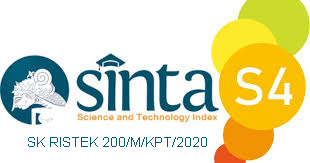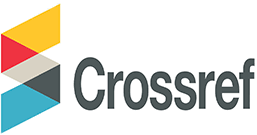DEVELOPMENT OF ARTS LEARNING MEDIA USING AUGMENTED REALITY WITH MARKERLESS BASED TRACKING METHOD AT SMKN 47
Abstract
During the transitional time between Covid-19 and endemic, all Indonesian schools, and SMKN 47 in particular, had restricted educational opportunities. Due to challenges encountered by the instructor and 36 students majoring in accounting in grade 12, they were unable to carry out teaching and learning activities at school; art lesson formats with three-dimensional learning modules must be visualized in 3D. However, with hybrid teaching and learning utilizing presentations, displaying the learned 3D forms is less successful. In order to visualize three dimensions in fine arts classes using augmented reality technology, we require a new learning medium. The application of the Markerless Based Tracking approach in this work enables the presentation of a tracked 3D model in the surrounding environment in real-time by merging the actual and virtual worlds as if their boundaries did not exist. The augmented reality system scans flat surfaces utilizing points, as opposed to markers or other auxiliary media. Points used as pedestals or containers to elevate three-dimensional items. There are three sculptures and three traditional dwellings on show. Online examination outcomes average resulted a 78.2% that the AR Fine Arts application by instructors and students are therefore consistent and well accepted.
Keywords
Full Text:
PDFReferences
A. Pauls and A. Karsakov, “The concept of using augmented reality technology to present interactive calligraphic objects,” in Procedia Computer Science, 2021. doi: 10.1016/j.procs.2021.10.042.
J. D. Hincapié-Ramos, K. Özacar, P. P. Irani, and Y. Kitamura, “GyroWand: An approach to IMU-based raycasting for augmented reality,” IEEE Comput. Graph. Appl., 2016, doi: 10.1109/MCG.2016.21.
F. Arici, P. Yildirim, Ş. Caliklar, and R. M. Yilmaz, “Research trends in the use of augmented reality in science education: Content and bibliometric mapping analysis,” Comput. Educ., 2019, doi: 10.1016/j.compedu.2019.103647.
S. C. Chang and G. J. Hwang, “Impacts of an augmented reality-based flipped learning guiding approach on students’ scientific project performance and perceptions,” Comput. Educ., 2018, doi: 10.1016/j.compedu.2018.06.007.
A. J. Moreno-Guerrero, A. M. Rodríguez García, M. R. Navas-Parejo, and C. R. Jiménez, “Digital literacy and the use of augmented reality in teaching science in Secondary Education,” Rev. Fuentes, 2021, doi: 10.12795/REVISTAFUENTES.2021.V23.I1.12050.
S. Ceder and S. Ceder, “Augmented reality technology,” in Towards a Posthuman Theory of Educational Relationality, 2019. doi: 10.4324/9781351044196-11.
G. V. G. Putri, A. Syahputra, and S. D. H. Permana, “The Implementation of Augmented Reality Hairstyles at Beauty Salons Using the Viola-Jones Method (Case Study: Eka Salon),” JISA(Jurnal Inform. dan Sains), vol. 3, no. 2, 2020, doi: https://doi.org/10.31326/jisa.v3i2.847.
R. Mauludin, A. S. Sukamto, and H. Muhardi, “Penerapan Augmented Reality Sebagai Media Pembelajaran Sistem Pencernaan pada Manusia dalam Mata Pelajaran Biologi,” J. Edukasi dan Penelit. Inform., vol. 3, no. 2, p. 117, 2017, doi: 10.26418/jp.v3i2.22676.
W. Ramadhan, B. Arifitama, and S. D. H. Permana, “Mobile augmented reality for furniture visualization using Simultaneous Localization and Mapping (SLAM),” IOP Conf. Ser. Mater. Sci. Eng., 2021, doi: 10.1088/1757-899x/1098/6/062008.
D. Rohendi and Y. Wihardi, “Learning Three-Dimensional Shapes in Geometry Using Mobile-Based Augmented Reality,” Int. J. Interact. Mob. Technol., vol. 14, no. 09, p. 48, 2020, doi: 10.3991/ijim.v14i09.13035.
G.-J. Hwang, P.-H. Wu, C.-C. Chen, and N.-T. Tu, “Effects of an augmented reality-based educational game on students’ learning achievements and attitudes in real-world observations,” J. Interact. Learn. Enivronment, vol. 24, no. 8, pp. 1895–1906, 2016, doi: https://doi.org/10.1080/10494820.2015.1057747.
A. A. M. Akbar, “Sistem Pemandu Wisata Berbasis Augmented Reality Markerless Memanfaatkan GPS Based Tracking Dengan Platform Android (Studi Kasus : Lokasi Wisata di Kota Makassar),” Universitas Islam Negeri Alauddin Makassar, 2017.
H. Hermawan, R. Waluyo, and M. Ichsan, “Pengembangan Media Pembelajaran Mesin Menggunakan Teknologi Augmented Reality,” J. Innov. Inf. Technol. Appl., 2019, doi: 10.35970/jinita.v1i01.88.
M. Reyhan, H. Tolle, and L. Fanani, “Pembangunan Aplikasi Entertainment Terminal Berbasis Sistem Kendali Head Movement Control System pada Perangkat IOS,” J. Pengemb. Teknol. Inf. dan Ilmu Komput. Univ. Brawijaya, vol. 2, no. 9, pp. 3258–3263, 2018.
B. Satria and P. Prihandoko, “IMPLEMENTASI METODE MARKER BASED TRACKING PADA APLIKASI BANGUN RUANG BERBASIS AUGMENTED REALITY,” Sebatik, 2018, doi: 10.46984/sebatik.v19i1.88.
I. M. O. Widyantara, D. M. Wiharta, and P. Widiadnyana, “Implementasi Aplikasi Mobile Augmented Reality Untuk Pengenalan Materi Bangun Ruang,” J. Teknol. Inf. dan Ilmu Komput., vol. 9, no. 2, pp. 313–322, 2022, doi: 10.25126/jtiik.202295032.
M. A. Muhammad et al., “Augmented Reality Pelacak Lokasi Pustaka,” J. Teknol. Inf. dan Ilmu Komput., vol. 7, no. 1, pp. 77–86, 2020, doi: 10.25126/jtiik.202071343.
A. K. Dash, S. K. Behera, D. P. Dogra, and P. P. Roy, “Designing of marker-based augmented reality learning environment for kids using convolutional neural network architecture,” Displays, 2018, doi: 10.1016/j.displa.2018.10.003.
J. C. Piao and S. D. Kim, “Adaptive monocular visual-inertial SLAM for real-time augmented reality applications in mobile devices,” Sensors (Switzerland), 2017, doi: 10.3390/s17112567.
B. Arifitama, A. Syahputra, S. D. H. Permana, and K. B. Y. Bintoro, “Mobile Augmented Reality for Learning Traditional Culture Using Marker Based Tracking,” in IOP Conference Series: Materials Science and Engineering, 2019. doi: 10.1088/1757-899X/662/2/022038.
DOI: https://doi.org/10.31326/jisa.v6i2.1758
Refbacks
- There are currently no refbacks.
Copyright (c) 2023 Ghali Hanan, Budi Arifitama, Silvester Dian Handy Permana

This work is licensed under a Creative Commons Attribution-ShareAlike 4.0 International License.
JOURNAL IDENTITY
Journal Name: JISA (Jurnal Informatika dan Sains)
e-ISSN: 2614-8404, p-ISSN: 2776-3234
Publisher: Program Studi Teknik Informatika Universitas Trilogi
Publication Schedule: June and December
Language: English
APC: The Journal Charges Fees for Publishing
Indexing: EBSCO , DOAJ, Google Scholar, Arsip Relawan Jurnal Indonesia, Directory of Research Journals Indexing, Index Copernicus International, PKP Index, Science and Technology Index (SINTA, S4) , Garuda Index
OAI address: http://trilogi.ac.id/journal/ks/index.php/JISA/oai
Contact: jisa@trilogi.ac.id
Sponsored by: DOI – Digital Object Identifier Crossref, Universitas Trilogi
In Collaboration With: Indonesian Artificial Intelligent Ecosystem(IAIE), Relawan Jurnal Indonesia, Jurnal Teknologi dan Sistem Komputer (JTSiskom)
JISA (Jurnal Informatika dan Sains) is Published by Program Studi Teknik Informatika, Universitas Trilogi under Creative Commons Attribution-ShareAlike 4.0 International License.


















